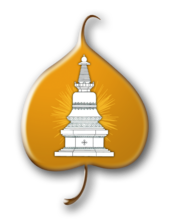Since Its Beginning, Buddhism has been intimately concerned with confronting and understanding death and dying. Indeed, the tradition emphasizes turning toward the realities of sickness, old age, and death-and using those very experiences to develop wisdom and liberating compassion. In recent decades, Buddhist chaplains and caregivers all over the world have been drawing on this tradition to contribute greatly to the development of modern palliative and hospice care in the secular world at large. Specifically Buddhist hospice programs have also been further developing and applying traditional Buddhist practices of preparing for death, attending to the dying, and comforting the bereaved.
Sample Bookstore Titles
Here's a sample of what's in our bookstore. We regularly stock our store with new books and other items, so come on in and take a look. You'll want to add just one more (or many more) things to your bookshelf.
Prior to his thirty-year career in the first-ever academic Buddhist studies program in the United States, Geshé Sopa was the son of peasant farmers, a novice monk in a rural monastery, a virtuoso scholar monk at one of the prestigious central monasteries in Lhasa, and a survivor of the Tibetan uprising and perilous flight into exile in 1959. In Like a Waking Dream, Geshé Sopa frankly and observantly reflects on how his life in Tibet, a monastic life of yogic simplicity, shaped and prepared him for the unexpected. The account of his years in Tibet preserves, as well, valuable insight and details about a now-vanished era of Tibetan religious culture. His is a tale of an exemplary life dedicated to learning, spiritual cultivation, and the service of others from one of the greatest living masters of Tibetan Buddhism.
Thunderous Silence is a lively and accessible exposition of the Heart Sutra that sheds new light on this essential Buddhist text. Dosung Yoo examines the sutra phrase by phrase, using rich explanations and metaphors drawn from Korean folklore, quantum physics, Charles Dickens, and everything in between to clarify subtle concepts for the reader. This book invites us to examine the fundamentals of Buddhism-the Four Noble Truths, emptiness, enlightenment-through the prism of the Heart Sutra. Both those new to Buddhism and longtime practitioners looking to revisit a core text from a fresh perspective will find this work appealing.
When the Dalai Lama was forced to go into exile in 1959, he could take only a few items with him. Among these cherished belongings was his copy of Tsong-kha-pa’s classic text The Great Treatise on the Stages of the Path to Enlightenment. This text distills all of the essential points of Tibetan Buddhism, clearly unfolding the entire Buddhist path to enlightenment. In 2008, celebrating the long-awaited completion of the English-language translation of The Great Treatise, the Dalai Lama gave a historic six-day teaching at Lehigh University to explain the meaning of this classic text and to underscore its importance.
An intensely personal portrait of the Dalai Lama, it recounts the story of his friendship with a blind Irishman, how they first met and how in later meetings the Dalai Lama comes to call him his one and only hero. It explores the Dalai Lama’s collaboration with a neuroscientist and how it results in significant discoveries about the human brain. It also brings to life poignant accounts of his uncommon encounters with a little beggar girl, a disabled boy in a critical care ward, a man who trains grandmothers to become solar engineers, and many others. The Dalai Lama’s wisdom principles revolve around the practical application of compassion. Enhanced by his seven decades of practice and elucidated through captivating anecdotes of his own experiences, they will help readers lead more fulfilling lives. As the Dalai Lama has written many years ago: if you want others to be happy, practice compassion; if you want yourself to be happy, practice compassion.
If you are inspired to take up his challenge, the Karmapa offers a path for participating in a global community that is based on compassion. In these chapters, he shares his vision for bringing social action into daily life, on a scale we can realistically manage through the choices we make every day—what to buy, what to eat, and how to relate honestly and bravely with our friends and family and coworkers. His fresh and encouraging perspective shows us that we have the strength to live with kindness in the midst of the many challenges we face as socially and environmentally conscious beings.

Tsoknyi Rinpoche—one of the most beloved of the contemporary generation of Tibetan Buddhist meditation masters—explains that a life free of fear, pain, insecurity, and doubt is not only possible, it’s our birthright. We long for peace, for the ability to love and be loved openly and freely, and for the confidence and clarity to meet the various challenges we face in our daily lives. Within each of us resides a spark of unparalleled brilliance, an unlimited capacity for warmth, openness, and courage, which Rinpoche identifies as “essence love.”

Why do we suffer? Is there a purpose to our pain? Noting that human beings have wrestled with such questions for thousands of years, Phillip Moffitt has found answers for his own life in Buddhist philosophy and meditation. Reflecting on his own journey from Esquire magazine editor-in-chief to Buddhist meditation teacher, Moffitt provides a fresh perspective on the Buddha's ancient wisdom, showing how to move from suffering to new awareness and unanticipated joy.

Highlights of the new issue of Mandala include:
- The Importance of Retreat By Lama Zopa Rinpoche
- Subduing the Mind, Actualizing the Path: The Time for Retreat is Now
- Kalachakra for World Peace 2012
- Training for Retreat By Ven. Lhundup Nyingje (Paula Chichester)
- Khenrinpoche Geshe Chonyi: A Kopan Monastery Homecoming
- ... and much more! All for only $6.25 including tax.



